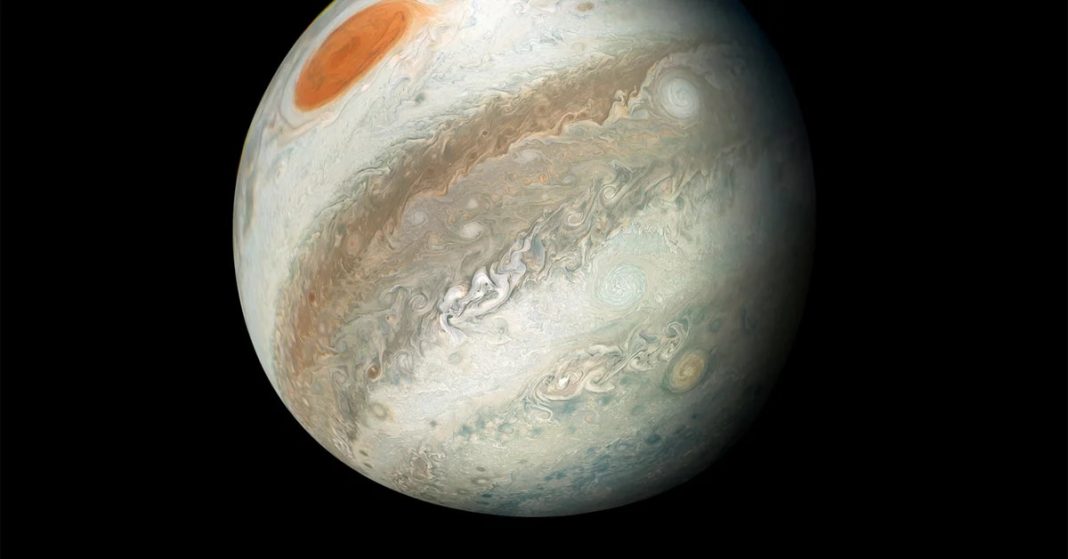:quality(85)/cloudfront-us-east-1.images.arcpublishing.com/infobae/E7OJI73KABCIXM2J7GRQKWUXMI.jpeg 420w)
Scientists from the United States were able to determine this Giant tornadoes that occur at the poles of Jupiter are generated by The same forces that move water in Earth’s oceans.
To do this, they analyzed images produced by Juno, a NASA-funded satellite orbiting Jupiter and its 79 moons. Its images of the solar system’s largest planet served as excellent material for Oceanographers on Earth describe the rich perturbations at Jupiter’s poles and the physical forces that drive large hurricanes.
The study was published in Nature Physics Its lead author is Lia Siegelman, a physical oceanographer and postdoctoral fellow at the Scripps Institution of Oceanography at the University of California, San Diego. I decided to continue investigating after noticing it Hurricanes at Jupiter’s pole seem to share similarities with the oceanic eddies he studied during his time as a doctoral student.
Using a series of these images and principles used in geophysical fluid dynamics, Siegelman and colleagues provide evidence for a long-standing hypothesis that Moist convection, when warmer and less dense air rises, drives these hurricanes.
“When I saw the richness of the turbulence around Hurricanes Jovian with all the threads and the smaller eddies, it reminded me of the turbulence you see in the ocean around the eddies.” Siegelman said. This is particularly evident in high-resolution satellite images of plankton flowers, for example.
Siegelman says that understanding Jupiter’s energy system, which is a much larger scale than Earth, can also help us understand the physical mechanisms operating on our planet by Highlighting some of the energy pathways that can also exist on Earth.
“Being able to study a planet so far away and find applicable physics there is great,” He said. “The question arises, are these operations also valid for our blue dot?”
Juno is the first spacecraft to take pictures of Jupiter’s poles. Previous satellites orbit the equatorial region of the planet, Provide views The famous red spot on the planet.
Juno is equipped with two camera systems, one for visible-light imaging and one for capturing thermal signatures using the Jovian Infrared Auroral Mapper (JIRAM), an instrument on the Juno spacecraft with support from the Italian Space Agency.
:quality(85)/cloudfront-us-east-1.images.arcpublishing.com/infobae/QZR3I7O275HKJJUAB5A4OY3Y2I.jpeg 420w)
Siegelman and colleagues analyzed a series of infrared images that capture Jupiter’s north polar region, and in particular, its polar vortex array. from pictures The researchers were able to calculate the wind speed and direction by following the movement of clouds between the images. The team then interpreted the infrared images in terms of the thickness of the clouds. Warm regions correspond to thin clouds, where greater depth can be seen in Jupiter’s atmosphere. Cold regions represent a thick layer of clouds that cover Jupiter’s atmosphere.
These results gave the researchers clues about the energy of the system. Since Jovian clouds form when warmer and less dense air rises, researchers have found that The rapidly rising air within the clouds acts as an energy source that fuels even larger scales of polar and arctic cyclones.
:quality(85)/cloudfront-us-east-1.images.arcpublishing.com/infobae/HAQT4FZAYVHLRNJWENSRQHGOR4.jpeg 420w)
Juno first reached the Jovian system in 2016, giving scientists their first look at these large polar cyclones, which have a radius of about 1,000 kilometers.. Eight of these hurricanes occur in the north pole of Jupiter and five in the south pole. These storms have been around since that first sight five years ago. Researchers are not sure how it originated or how long it has been in circulation, But they now know that moist convection is what sustains them. Researchers first hypothesized this energy transfer after observing lightning strikes in Jupiter’s storms.
Juno will continue to orbit Jupiter until 2025, providing researchers and the public New images of the planet and its vast lunar system.
Read on

“Wannabe internet buff. Future teen idol. Hardcore zombie guru. Gamer. Avid creator. Entrepreneur. Bacon ninja.”




